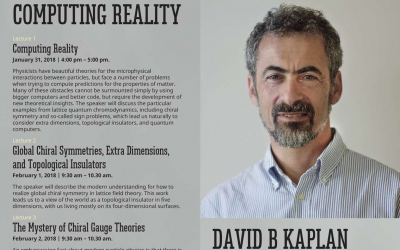Lecture 1: 31 January 2018, 16:00 to 17:00
Title: Computing Reality.
Abstract: Physicists have beautiful theories for the microphysical interactions between particles, but face a number of problems when trying to compute predictions for the properties of matter. Many of these obstacles cannot be surmounted simply by using bigger computers and better code, but require the development of new theoretical insights. The speaker will discuss the particular examples from lattice quantum chromodynamics, including chiral symmetry and so-called sign problems, which lead us naturally to consider extra dimensions, topological insulators, and quantum computers.
Lecture 2: 1 February 2018, 09:30 to 10:30
Title: Global chiral symmetries, extra dimensions, and topological insulators.
Abstract: The speaker will describe the modern understanding for how to realize global chiral symmetry in lattice field theory. This work leads us to a view of the world as a topological insulator in five dimensions, with us living mostly on its four-dimensional surfaces.
Lecture 3: 2 February 2018, 09:30 to 10:30
Title: The Mystery of Chiral Gauge Theories.
Abstract: An embarrassing fact about modern particle physics is that there is no known way to define the Standard Model nonperturbatively. The problem is a general one with chiral gauge theories. A possible starting point for a solution inspired by the solution for global chiral symmetries anticipated the Quantum Spin Hall Effect discovered by condensed matter physicists over a decade later. However, from there the path is obscure: one direction requires invoking dynamical behavior for which there is no evidence, while another leads to a world with exotic particles that interact with ordinary matter non-locally through topological fluctuations.
Lecture 4: 3 February 2018, 09:30 to 10:30
Title: Sign problems and quantum computers.
Abstract: Even if we can discover a nonperturbative formulation of chiral gauge theories like the Standard Model, we will be faced with a hard computational problem whose difficulty scales exponentially with the size of the system. This so-called sign problem is ubiquitous in the study of many-body quantum systems and is one of the greatest obstacles currently to making conceptual and technological breakthroughs in the study of quantum matter, from understanding the cores of neutron stars, to high temperature superconductors, topological field theories and M-theory. I discuss the nature of the sign problem, how quantum computers have the potential to solve it, and the first steps taken in this direction.
This lecture series is part of Nonperturbative and Numerical Approaches to Quantum Gravity, String Theory and Holography


